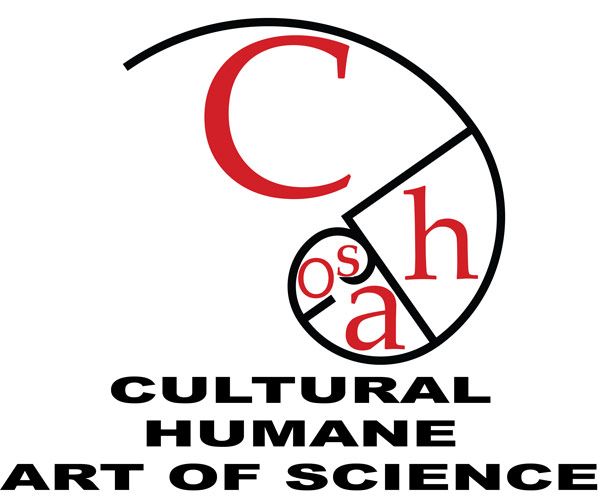research proposal No2
(this text is an extended version of what is already written in the ‘Business Modeling for Sustainable Digitalisation‘ chapter of the ‘cover letter + research interests’)
Excellence
The vital aspect of this proposal is that it is pluggable into a bigger context of the Sustainable Digitalisation research project, due to its independent modular approach.
I propose research in the area of Business Modeling to support Digitalisation of the Business Models, toward Sustainable Digitalisation. We (I and my team) believe that this is one of the essential steps to survive and strive on Digital Disruption (DD). We address ‘Crowdsourcing turn’ and Collective Intelligence as substantial aspects of DD, and on addressing them in business models.
Our experience from the work with practitioners (in the field of business, education, societal change, SEA (Helguera, 2011) shows that one of the most significant barriers preventing them from implementing socio-IT augmentation (besides face-to-virtual frictions being addressed with our HCI approaches - CoEvoLudens [1]and ColaboWare[2]) is the fact that many of them fail to understand and/or respond appropriately to DD. This experience is supported by the research in industry (Bughin & Van Zeebroeck, 2017). It is explained due to generally being difficult to change structures that have emerged from adaptation to previously prevalent environmental conditions (Skog et al., 2018). Research also shows that understanding of sustainable business models and how sustainable development is operationalized in firms is weak (Bansal, 2005; Sharma, 2002).
Here we propose a model that would enable an incremental digitalisation of their practices as well as its understanding, enabling practitioners to become co-designers of that digitalisation.
Additionally, a high percentage of ‘old-school’ practitioners embrace face-to-face practice and do not see benefits from digitalisation of their practice. Therefore, they fight it, not understanding that DD is a negative force only for those who chose to ignore it or try to fight it. We address it by providing a benefit for them through Colabo.ReM evaluation integrated into their processes.
Concept
We propose a solution that would support (i) identifying and describing fundamental entities of a business model (process), (ii) describing a constellation of those entities into a coherent “flow” of the business model, (iii) evaluating and evolving business models as a part of the incremental digitalisation process.
(I) Identifying and describing business model entities
For identifying and describing business model entities, we propose an approach that would capitalize on (Malone et al., 2009) by building on the framework similar to ones that have been developed in the field of organizational design (Kates & Galbraith, 2010). It relies on answering the questions:
– Who is performing the task (in the specific MindStuff)? Why are they doing it?
– What is being accomplished (in the specific MindStuff)? How is it being done?
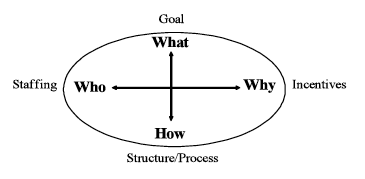
Illustration: Classifying questions - leading to “genes” (Malone et al., 2009)
Mapping the MindStuff (Colabo.Space puzzles) as Collective Intelligence Genes
In our Colabo.Space[3] notation such fundamental components of a business model/process are called MindStuffs[4] (a conceptual term) or Colabo Puzzles (a practical term related to Colabo.Space). Further on, we will use the term MindStuff, when addressing fundamental entities of business models.
(Malone et al., 2009) scanned and identified the underlying building blocks—to use a biological metaphor, the “genes”—that are at the heart of collective intelligence systems, the conditions under which each gene is useful, and the possibilities for combining and re-combining these genes to harness crowds effectively.
Work of (Malone et al., 2009) supports classifying of MindStuffs on a higher conceptual level, their understanding by non-specialists and interdisciplinary practitioners. Nevertheless, we find the CI genes classification not being expressive enough and often over-simplistic. Through additional layers and further decorations and subclasses, we are looking to reach the desired level of descriptiveness.
Our goal was not to focus solely on online Collective Intelligence practices but to identify and explain face-to-face collective practices in a similar manner. This would enable us to classify face-to-face MindStuff, to mockup them in face-to-face / offline world, to enable their description by the proposed classification (cartography), with the primary goal of enabling incremental integration of (online) MindStuff through the digitalisation process of migration from face-to-face (offline) to face-to-virtual (online).
Here we reinforce our holistic/balanced approach toward the frictionless coexistence of face-to-face and face-to-virtual processes and modeling of their interactions.
An additional extension of the original CI Genes model is in adding Genes representing AI and other forms of Computer-guided interactions, e.g. new WHO gene - Computer. While (Malone et al., 2009) tried to put the light on the human side of the CI factor, 'hiding' the computational side of it in the final model, our experience shows that in practice it disables us in clearly demonstrating origins of decisions and blurs communication. At the excerpt of CI genome mapping of a Mindstuff (fig. mindstuff-ci-genes), a reader can notice mentioned extensions to the original genome.

Figure mindstuff-ci-genes: a MindStuff mapped through the Collective Intelligence genome (an excerpt)
We also used CI Genome for describing ColaboFLow[5] diagrams, where it is further accompanied with modeling capabilities for describing (i) the change happening in the Collective Mind; (ii) context of the specific process/action; (iii) connections among processes.
(II) Describing business model flows (processes)
ColaboFlow - as a language for digitizing business models
At the (fig. ColaboFlow-visual-extension) we show extensions we propose.
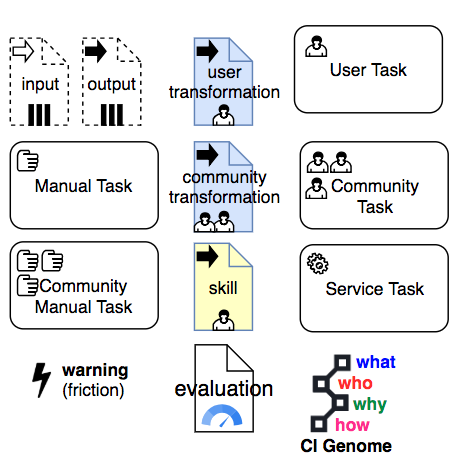
Figure ColaboFlow-visual-extension: Relevant visual extension of the BPMN notation
The figure reflects the key aspects we addressed when developing the ColaboFlow extension, which are:
- cartographic - cartographic aspect
- persona - persona flows
- AT - Activity Theory (Leont'ev, 1974) friendly flows (human-, freedom-, creativity-first)
- ANT - Actor-Network Theory (Latour, 1996) supporting flows
- social - social flows
- face-to-virtual (F2V) - face-to-virtual and low-friction flows
- semantical - semantical flows (please check the Bukvik[6] ColaboFlow implementation)
- EvoLuation - EvoLuation (evaluation + evolution)-friendly flows
- collective-mind - collective-mind-friendly flows (both knowledge- and dynamic-wise)
At the (fig. ColaboFlow-declarative-extension) we present an excerpt of the ColaboFlow declarative extensions that provide decorations of standard BPMN entities.
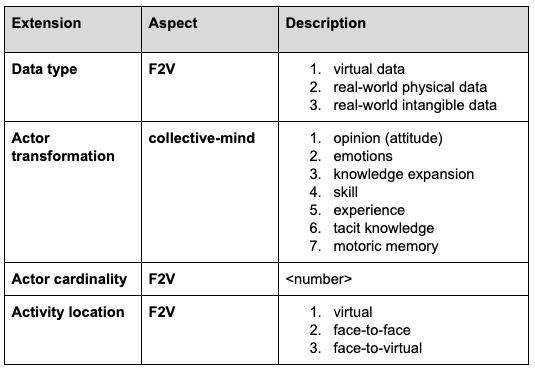
Figure ColaboFlow-declarative-extension: Excerpt of ColaboFlow declarative extension of the BPMN notation
Digitizing business models
We have successfully mapped (fig. ColaboFlow-a; fig. ColaboFlow-b) our SDG-related workshop that happened in a face-to-virtual scenario with an ad-hoc community of civil-rights NGOs founders. The workshop itself was a demonstration of digital disruption - with a community not keen to digital augmentation of their face-to-face events. As such, we had the very sensitive task of “digitizing” their practice from face-to-face into face-to-virtual, and “patching” it at particular spots with digital augmentation and re-contextualization of their activities in the SDG perspective in parallel.
By relying on the standard BPMN, we could digitize the workflow. However, BPMN (i) lacks support for the evolutive nature of digitization process and (ii) descriptiveness necessary to design and analyze potential digitization disruption challenges and (augmentation) opportunities. Therefore in our Colabo.Space solution we have extended BPMN language into ColaboFlow language.
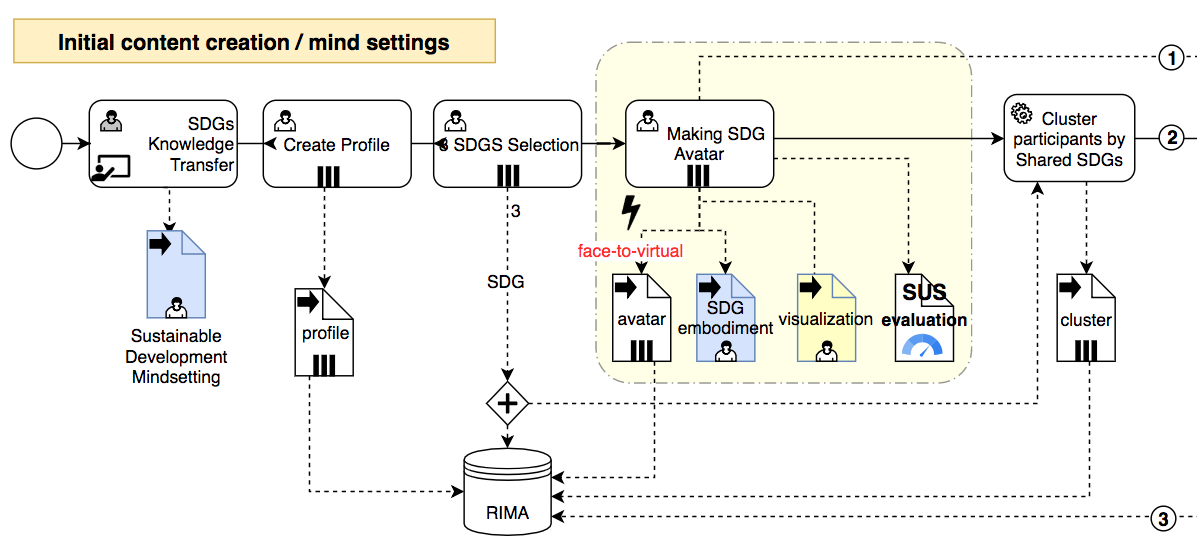
Figure ColaboFlow-а: Workflow (ColaboFlow) of the face-to-virtual SDG inspired workshop (part 1)
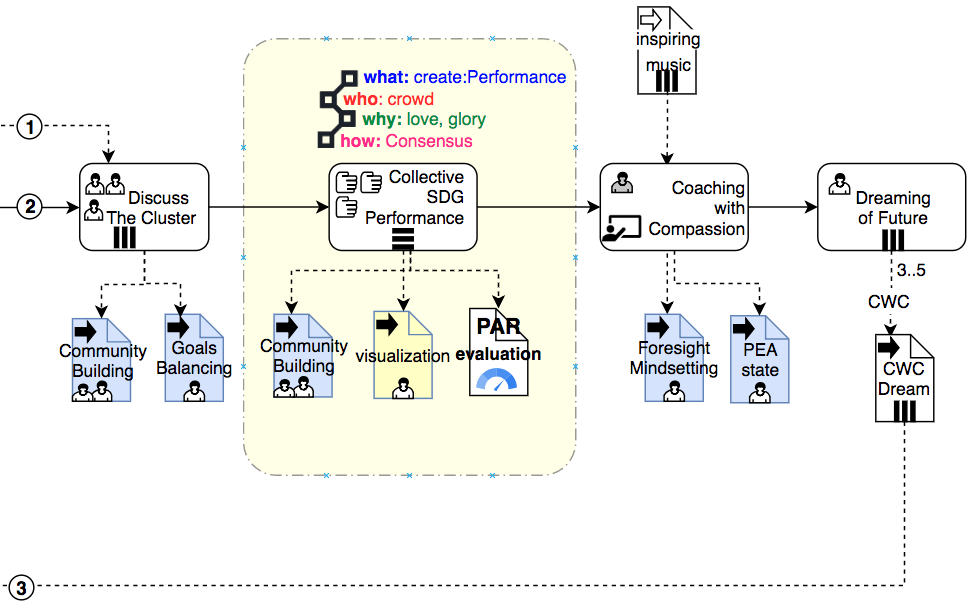
Figure ColaboFlow-b: Workflow (ColaboFlow) of the face-to-virtual SDG inspired workshop (part 2)
The process of workflow digitizing consists of (i) identifying (in a participatory manner with domain experts, community members) the known activities the process should consist of, and describing them as best as we can; followed with (ii) basic extensions we want to contribute with at the particular event; and understanding what are potential (iii) frictions and (iv) digital disruption in the proposed workflow. To be able to do that properly, we need to understand the nature and impact of each activity toward individuals, community dynamics, social objects, social ecology and the context the activity is executed in.
To support the understanding of each activity, we can decorate them with CI genes or describe their position in the CSCW matrix or other metrics relevant for a particular business model.
After describing activities, we can identify potential issues, like frictions, or digital disruptions and aim for treating them. Identifying issues can be done either through (i) a transformative design process - analysis of problems and opportunities, and discussing what activities can be compensated or supported with compensating activities, or (ii) we can provide a digital evaluation and health monitoring of the workflow by using Colabo.ReM as explained in the following section.
(III) EvoLuation - Evaluating and evolving business models
Colabo.ReM Evaluation Toolset
By understanding the limitations of the evaluation methodology, especially taking in mind new capacities of digitalized (business) processes, we have realized that we need more accurate instruments to evaluate creative, collaborative processes***.*** We experienced the lacking of CSI (Carroll et al. 2009) and SUS (Brooke, 1996) scales, mainly in terms of the capacity to isolate the source of the observed phenomena, their inherent summative and "opaque" nature that disrupts natural flow.
Addressing this, my team and I and work on the development and evaluation of the Colabo.ReM research method. It is a novel evaluation method with the potential of being useful for a range of research projects and an indispensable aspect of our research toolset and Colabo.Space, and I believe that it would benefit the SusDig PhD as well.
Integrating ColaboFlow concepts allows designers and developers to observe and evaluate (objectively and subjectively) the usability and creativity (among other aspects) of a system, in-vivo, during the community practice. They can address a particular action, an individual task, and even their context (the object of the work, "surrounding" tasks, collaborators that participated in the task, and the history of interactions).
Using appropriate process mining (van der Aalst, 2015) and data mining, we can find the patterns and underlying answers and nail the sources of usability issues or find the most creative-supporting aspects of the system. Thus, we can implicitly (which is cheaper to conduct) rather than explicitly build value models and chains (Alexopoulos et al. 2012) and understand what are the most impactful and necessary system changes that we could implement to increase system value (e.g. its usability or creativity). In such an in-vivo way, it becomes possible to engage with users, to even gamify the process of evaluation, and to make it less demanding (by asking participants a single question at a time through a highly contextualized inquiry, increasing incentive and value for the evaluatee)
Additionally, by merely providing users with choices in their activities and observing these choices, we can provide A/B testing and observation mechanism. It unlocks possibilities for unobtrusive evaluation, which is of а crucial importance when evaluating socio-technical systems, where evaluating social aspects distort them.
We believe that this concept supports the evaluation of research/social/CSCL[7] impacts (Stahl et al., 2006) and improves the HCI practice.
Evolution of Business Models
Having (i) fundamental entities of the business model described and identified, (ii) “flow” of the business model identified and visualized, and (iii) mechanism for evaluation of business models; we can proceed with the next phase of the evolution and incremental digitalisation process.
As a generic and pluggable solution, this proposal allows various means of integration, improvement and digitalisation methodologies. Here we will present just a few possible solutions.
By being distinctively visualized, we can precisely address each of business model entities. We can use discussion and argumentation tools to understand and argue about each entity - what is its importance, issues, how to evolve it. We can associate a “discussion bubble” to each entity and invite experts and policymakers to contribute and provide broader perspectives (nicely supporting my research proposal No1).
We can gather findings and observations from the related practice and “attach” them to the digital representation of entities in the model and thus support decision making, and understanding of critical spots in our models. Through these findings and discussion, we can “fork” [8] business models, compare and evaluate them.
Having a business model semantically described, with some of its aspects digitalized and running in a virtual environment, we can use Colabo.ReM to evaluate and evolve business models. Similarly, we are capable of using Agent-based modeling (ABM) (Bonabeau, 2002; Garcia, 2005), Social Network Analysis (SNA) and similar instruments to simulate (aspects) of the model. This helps us to understand critical border cases, identify (digital) disruptions and early in a (re)design and transformation process, choose, compare and identify the most optimal version (fork) of the model.
Application. Practice
Probably the most exciting opportunity of having business models digitized (not to be mistaken with ‘digitalized’[9]) is in the possibility to open them to the community, either internal - as we already suggested, but more interestingly to business consumers, the crowd. We are capable of augmenting the digitized business model with knowledge, discussion and the most important the open innovation tools (such as Induct Software[10]).
The proposed concept can support getting customers (stakeholders) reflections on the business models, but also the crowdsourcing business models digitalisation in order to solve disruption challenges and identify opportunities.
In order to support these processes, we practice the development of contextualized games with game mechanic corresponding to the digitized business model. They address important challenges: community motivation and engagement, immersion and contextualization of model evaluators, the possibility of realistic model simulation with genuine actors, and reinforcing patterns from the business model in the community. We have implemented this in City Game[11], where we practiced co-evolution of cities toward competitive futures with limited resources. Having “business model” digitized, we were able to use CoEvoLudens methodology to co-evolve communities from disjunctive or dissociative social processes toward conjunctive or associative social process (Bardis, 1979) and evaluate the success of the change with the Colabo.ReM evaluation toolset. Similarly, we have designed the game PlaySustainability![12], involving UN SDGs as a part of the process of redesigning societal processes toward sustainable goals.
In the attached ‘Use Cases’ document, more practices and digitalized business models are provided.
The possibilities opened by this approach and the relevant topics are addressed in higher details in my research proposal No1 - DesignSustainability!
Implementation
This line of research is supported with both methodologies and technology of the open source IT ecosystem Colabo.Space, which is actively being developed and improved by my research team.
The technological know-how, UI design, and more from my IT-background can be assessed through my open source contributions to the code at https://github.com/Cha-OS/colabo.
References
- Alavi, M. (1994). Computer-mediated collaborative learning: An empirical evaluation. MIS quarterly, 159-174.
- Alexopoulos, C., Loukis, E., Charalabidis, Y., & Tagkopoulos, I. (2012, October). A Methodology for Evaluating PSI E-infrastructures Based on Multiple Value Models. In 2012 16th Panhellenic Conference on Informatics (pp. 37-43). IEEE.
- Bansal, P. (2005). Evolving sustainably: A longitudinal study of corporate sustainable development. Strategic management journal, 26(3), 197-218.
- Bardis, P. D. (1979). Social interaction and social processes. Social Science, 54(3), 147-167.
- Bonabeau, E. (2002). Agent-based modeling: Methods and techniques for simulating human systems. Proceedings of the national academy of sciences, 99(suppl 3), 7280-7287.
- Brooke, J. (1996). SUS-A quick and dirty usability scale. Usability evaluation in industry, 189(194), 4-7.
- Bughin, J., & Van Zeebroeck, N. (2017). The best response to digital disruption. MIT Sloan Management Review, 58(4), 80-86.
- Carroll, E. A., Latulipe, C., Fung, R., & Terry, M. (2009, October). Creativity factor evaluation: towards a standardized survey metric for creativity support. In Proceedings of the seventh ACM conference on Creativity and cognition (pp. 127-136). ACM.
- Christensen, C. M., Raynor, M. E., & McDonald, R. (2015). What is disruptive innovation. Harvard Business Review, 93(12), 44-53.
- Garcia, R. (2005). Uses of agent‐based modeling in innovation/new product development research. Journal of Product Innovation Management, 22(5), 380-398.
- Helguera, P. (2011). Socially engaged art. New York, NY: Jorge Pinto Books
- Latour, B. (1996). On actor-network theory: A few clarifications. Soziale welt, 369-381.
- Leont'ev, A. (1974). The problem of activity in psychology. Soviet Psychology 13(2):4–33.
- Malone, T. W., Laubacher, R., & Dellarocas, C. (2009). Harnessing crowds: Mapping the genome of collective intelligence.
- Shapira, H., Ketchie, A., & Nehe, M. (2017). The integration of design thinking and strategic sustainable development. Journal of Cleaner Production, 140, 277-287.
- Sharma, S. (2002). Research in corporate sustainability: What really matters. Research in corporate sustainability: The evolving theory and practice of organizations in the natural environment, 1-29.
- Skog, D. A., Wimelius, H., & Sandberg, J. (2018). Digital disruption. Business & Information Systems Engineering, 60(5), 431-437.
- Stahl, G., Koschmann, T. D., & Suthers, D. D. (2006). Computer-supported collaborative learning. Na.
- Stubbs, W., & Cocklin, C. (2008). Conceptualizing a “sustainability business model”. Organization & environment, 21(2), 103-127.
- van der Aalst, W. M. (2015). Extracting event data from databases to unleash process mining. In BPM-Driving innovation in a digital world (pp. 105-128). Springer, Cham.
MindStuff (Colabo Puzzles): https://cha-os.org/en/mindstuff-colabo-puzzles/ ↩︎
Bukvik: http://cha-os.org/bukvik ↩︎
CSCL - Computer-supported collaborative learning ↩︎
in a manner similar to forking open source coding projects ↩︎
Please check for the difference between two terms digitization and digitalisation ↩︎
Please check the product official website http://www.inductsoftware.com/ ↩︎
https://cha-os.org/en/sustainable-development/#play-sustainability ↩︎
